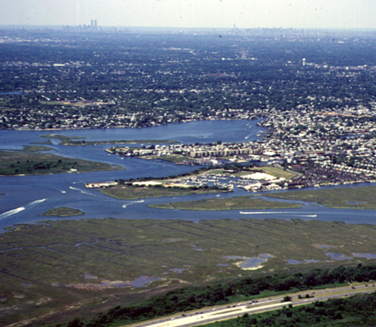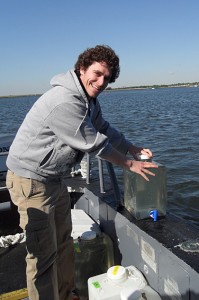Photo Above: A diver prepares to explore the western bays for a study conducted by SoMAS in 2010
The Stony Brook University School of Marine and Atmospheric Sciences (SoMAS) supports Nassau County and the City of Long Beach’s funding proposals for the implementation of the Long Beach Water Pollution Control Plant (WPCP) Consolidation Project.

The shoreline of the Western Bays region of the South Shore Estuary Reserve is highly developed and modified.
The Western Bays salt marsh ecosystem is an important wildlife habitat, recreational center, and aesthetic asset to Nassau County, but it has a number of significant environmental challenges. Among them are many water quality impacts that threaten public health as well as marine plants and animals. These impacts have been linked primarily to sewage treatment plant (STP) effluent. In fact, the NYS DEC and U.S. EPA considered the Western Bays impaired.
This project will convert the storm-vulnerable Long Beach WPCP into a pumping station with connection to the newly upgraded South Shore Water Reclamation Facility (Bay Park STP). When combined with the Bay Park Conveyance Project, the pump station will transport the treated water from the Bay Park STP to the Cedar Creek WPCP for discharge through an existing pipeline about three miles out in the ocean. This will result in a truly comprehensive and innovative regional wastewater management approach that will service close to one million residents. The outcome will contribute to the overall reduction in treated sewage and thus nitrogen loading into the Western Bays. The project will also create numerous economic opportunities by strengthening tourism and recreation in the region. When completed, these projects will represent a truly significant and lasting investment in bringing the water infrastructure in New York State into the 21st century.
It is largely because of the research undertaken and recommendations made by SoMAS investigators over the last decade that the Consolidation and Bay Park Conveyance Project were developed. Thus, we strongly support this grant application and its focus on improving the health of the estuary and nearshore waters as well as reducing the risk to public health. Further, it will assist in reducing acidification in our estuarine waters, a New York State goal. This coordinated effort between the City and the County will benefit Long Island and the region as a whole.
Thank you for your consideration to grant the necessary funding to implement this project to fruition.
Additional news coverage:





